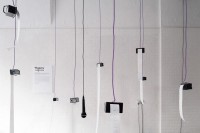BAT STUDIO
heard words
source: batstudiocouk
Between Art and Technology Studio was established by David Di Duca and Jonty Craig in 2012. David and Jonty combine skills and experience from professional backgrounds in architecture, art and installation design.
The studio was formed from a desire to develop inventive, considerate and fun solutions to designing spaces. Our approach is to design spaces as situations to be experienced. There is no space without an observer to inhabit it and as such we see people as the most important component in any installation.
We aim to create playful, fun spaces that delight and create a sense of wonder (in both senses of the word).
As a studio we offer professional design and management experience, with proven ability to deliver projects within budget and programme, but we also draw on experience as researchers in cutting edge spatial and experiential innovation.
Jonty Craig
Jonty is a qualified architect and has wide experience from Rick Mather Architects where his experience includes a number of successful competitions, as well as taking projects through to site. Prior to this he completed his Masters at the Bartlett School of Architecture, UCL (MArch) and has recently created a number of interactive art installations, including work exhibited at the ICA (Institute of Contemporary Art).
David Di Duca
In parallel to Between Art and Technology Studio, David Di Duca is a doctorate student from the Bartlett School of Architecture at UCL, where he first started studying architecture in 2002. His work investigates ideas relating to affordance, human-nonhuman interaction and cybernetics. He also has a wide range of professional experience working for architects, designers and artists including Jason Bruges, Tom Dixon and Usman Haque. Recently David managed the delivery of the centre piece of the Coca-Cola Beatbox Pavilion at the London 2012 Olympic Park, the installation Aerial Dynamics.
.
.
.
.
.
.
source: batstudiocouk
In response to a brief with the theme of historic professions, Heard Words creates a modern day scriveners’ (scribes’) office.
Sited in a disused shop, as visitors enter microphones are listening. When visitors speak, their words are transcribed by a series of machines dotted around the room. Every time someone speaks, the devices immediately reel out the words, printed onto streams of paper.
The space is fun to explore, with hundreds of previously (mis)transcribed snippets of spoken words to be read from the streams of paper. Over the course of the festival the room will become more and more full with the transcripts of the spoken words. Through doing so Heard Words creates a spatial and sculptural record of data collected from people who have been within the space.
Often very funny, the paper records seem to read as bizarre conversations or monologues, streams of consciousness that move fast between concepts and juxtaposed statements. One of these streams is digital and anyone can read the twitter feed of the transcribed Heard Words, from the installation in Chester, anywhere in the world.
Visitors to the space often start conversations with the installation. They perceive the installations mis-perceptions as responses to their utterances. This informs their next words and they often ask the installation questions. Driven by the nuances and idiosyncrasies of the transcriptions, this interaction facilitates anthropomorphic perceptions by the visitors. Observers see meaning in the streams and responses, which is often very funny and surreal!
Heard Words also tweets what it transcribes. Below is a live feed from twitter of the (mis)heard utterances of people visiting the exhibition.


